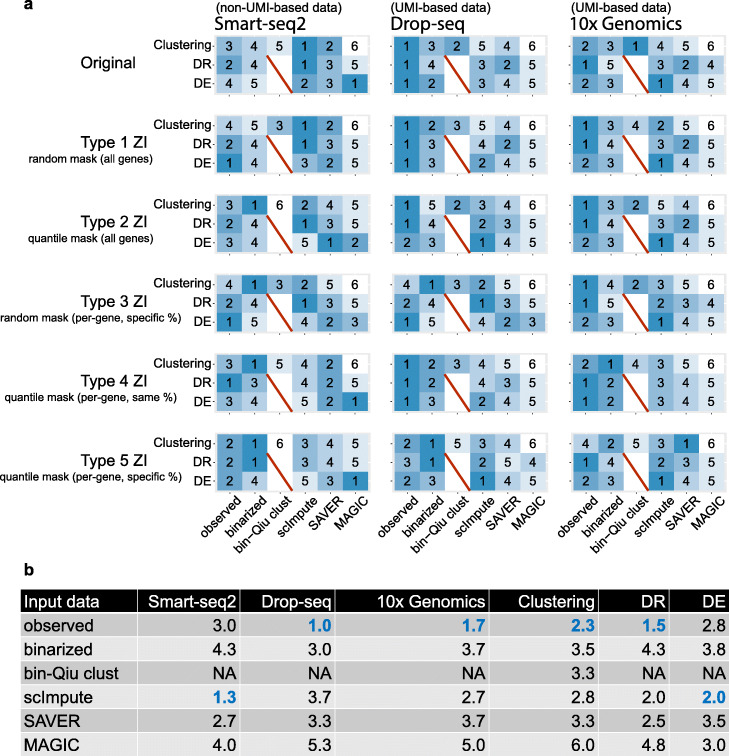Fig. 7.
Performance ranks of using observed, binarized, and imputed counts (from three experimental protocols and under five masking schemes) in three downstream analyses. a We perform cell clustering (Clustering), cell dimension reduction (DR), and gene differential expression (DE) analysis on the observed, binarized, and imputed counts of Smart-seq2, Drop-seq, and 10x Genomics data. We consider three popular imputation methods: scImpute, SAVER, and MAGIC. In addition to the original data, we use five masking schemes (Type 1 ZI–Type 5 ZI) to introduce 50% non-biological zeros and evaluate the effects on the downstream analyses with different input data. The five masking schemes are random mask (all genes), quantile mask (all genes), random mask (per-gene, specific %), quantile mask (per-gene, same %), and quantile mask (per-gene, specific %), corresponding to type 1 ZI–type 5 ZI, respectively. The six columns correspond to different input data types: observed counts, binarized counts, binarized counts analyzed by the Qiu’s clustering algorithm (bin-Qiu clust), imputed counts by scImpute, imputed counts by SAVER, and imputed counts by MAGIC. For cell clustering, except bin-Qiu clust, clustering is conducted by the Louvain clustering algorithm (in Seurat); clustering performance is ranked by the ARI. For cell DR analysis, we apply UMAP (in Seurat) to perform DR and calculate the average Silhouette score (based on known cell types) for each input data type to evaluate the DR performance. For gene DE analysis, we apply the two-sample proportion test to binarized counts and MAST (in Seurat) to observed, binarized, and imputed data to perform DE analysis. To rank the DE performance by the F1 score (at the 5% false discovery rate), since binarized counts have two DE methods, we compute the rank for the better-performing method in each comparison. In each row of each matrix, rank 1 indicates the best-performing input data type, while rank 6 indicates the worst. b On the original data, we compute the average ranks of the six input data types. Columns 2–4 show the average ranks for Smart-seq2 data, Drop-seq data, and 10x Genomics data across the three downstream analysis—cell clustering analysis, cell DR analysis, and gene DE analysis. Columns 5–7 show the weighted averages of the ranks for the three downstream analysis given the three protocols. Weights of 2, 1, 1 are used for Smart-seq2, Drop-seq, and 10x Genomics to ensure that the weights for non-UMI-based and UMI-based data are equal

